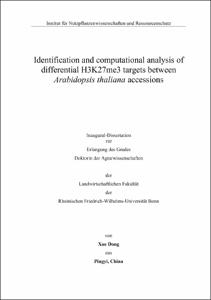Dong, Xue: Identification and computational analysis of differential H3K27me3 targets between Arabidopsis thaliana accessions. - Bonn, 2013. - Dissertation, Rheinische Friedrich-Wilhelms-Universität Bonn.
Online-Ausgabe in bonndoc: https://nbn-resolving.org/urn:nbn:de:hbz:5n-32525
Online-Ausgabe in bonndoc: https://nbn-resolving.org/urn:nbn:de:hbz:5n-32525
@phdthesis{handle:20.500.11811/5543,
urn: https://nbn-resolving.org/urn:nbn:de:hbz:5n-32525,
author = {{Xue Dong}},
title = {Identification and computational analysis of differential H3K27me3 targets between Arabidopsis thaliana accessions},
school = {Rheinische Friedrich-Wilhelms-Universität Bonn},
year = 2013,
month = jul,
note = {Histone H3 lysine 27 trimethylation (H3K27me3) and lysine 9 dimethylation (H3K9me2) are two independent repressive chromatin modifications in Arabidopsis thaliana. H3K27me3 is established and maintained by Polycomb repressive complexes whereas H3K9me2 is catalyzed by histone methyltransferases SUVH(4-6). H3K27me3 mostly targets at protein coding genes in euchromatin which are reversible in repression. H3K9me2 mainly targets at transposons and repetitive sequences which should be constitutively silenced. Both marks can spread to flanking regions after initialization and they have been shown to be mutually exclusive in distribution in the Arabidopsis genome. In this study, the extent of natural variation of H3K27me3 in the two accessions of Arabidopsis thaliana, Landsberg erecta (Ler) and Columbia (Col), and their hybrids was analyzed using chromatin immunoprecipitation followed by microarray or sequencing analysis (ChIP-chip and ChIP-seq). A computational workflow was implemented that includes remapping of probes to the Col and Ler genome assemblies in order to exclude differential signals due to genome polymorphisms.
The majority of genes that are H3K27me3 targets in Col are also targets in Ler and the F1 of reciprocal crosses. A small number of Ler-specific H3K27me3 targets were detected and well validated with independent ChIP-PCR whereas the Col-specific targets have not been confirmed so far. Ler-specific H3K27me3 targets showed an allele-specific H3K27me3 in both hybrids, consistent with a cis-regulatory mechanism for establishing H3K27me3.
Five Ler-specific H3K27me3 targets were marked by H3K4me3 in Col. Consistent with the activation role of H3K4me3 during transcription, the differential H3K27me3 of the these five genes accords to the expression variation between the two accessions. For the majority of Ler-specific H3K27me3 targets, no expression could be detected in Col, Ler or 17 other Arabidopsis accessions. Instead of H3K27me3, the antagonistic mark H3K9me2 and other heterochromatic features were observed at these loci in Col. More frequently than expected, transposable elements were found neighboring these loci in Col, and in many cases these transposable elements are missing in the Ler genome assembly. We propose a model where a transposon insertion specific to Col results in recruitment of H3K9me2, which spreads to neighboring genes already in a repressed state through H3K27me3, resulting in Ler-specific H3K27me3 as the ancestral state.},
url = {https://hdl.handle.net/20.500.11811/5543}
}
urn: https://nbn-resolving.org/urn:nbn:de:hbz:5n-32525,
author = {{Xue Dong}},
title = {Identification and computational analysis of differential H3K27me3 targets between Arabidopsis thaliana accessions},
school = {Rheinische Friedrich-Wilhelms-Universität Bonn},
year = 2013,
month = jul,
note = {Histone H3 lysine 27 trimethylation (H3K27me3) and lysine 9 dimethylation (H3K9me2) are two independent repressive chromatin modifications in Arabidopsis thaliana. H3K27me3 is established and maintained by Polycomb repressive complexes whereas H3K9me2 is catalyzed by histone methyltransferases SUVH(4-6). H3K27me3 mostly targets at protein coding genes in euchromatin which are reversible in repression. H3K9me2 mainly targets at transposons and repetitive sequences which should be constitutively silenced. Both marks can spread to flanking regions after initialization and they have been shown to be mutually exclusive in distribution in the Arabidopsis genome. In this study, the extent of natural variation of H3K27me3 in the two accessions of Arabidopsis thaliana, Landsberg erecta (Ler) and Columbia (Col), and their hybrids was analyzed using chromatin immunoprecipitation followed by microarray or sequencing analysis (ChIP-chip and ChIP-seq). A computational workflow was implemented that includes remapping of probes to the Col and Ler genome assemblies in order to exclude differential signals due to genome polymorphisms.
The majority of genes that are H3K27me3 targets in Col are also targets in Ler and the F1 of reciprocal crosses. A small number of Ler-specific H3K27me3 targets were detected and well validated with independent ChIP-PCR whereas the Col-specific targets have not been confirmed so far. Ler-specific H3K27me3 targets showed an allele-specific H3K27me3 in both hybrids, consistent with a cis-regulatory mechanism for establishing H3K27me3.
Five Ler-specific H3K27me3 targets were marked by H3K4me3 in Col. Consistent with the activation role of H3K4me3 during transcription, the differential H3K27me3 of the these five genes accords to the expression variation between the two accessions. For the majority of Ler-specific H3K27me3 targets, no expression could be detected in Col, Ler or 17 other Arabidopsis accessions. Instead of H3K27me3, the antagonistic mark H3K9me2 and other heterochromatic features were observed at these loci in Col. More frequently than expected, transposable elements were found neighboring these loci in Col, and in many cases these transposable elements are missing in the Ler genome assembly. We propose a model where a transposon insertion specific to Col results in recruitment of H3K9me2, which spreads to neighboring genes already in a repressed state through H3K27me3, resulting in Ler-specific H3K27me3 as the ancestral state.},
url = {https://hdl.handle.net/20.500.11811/5543}
}






